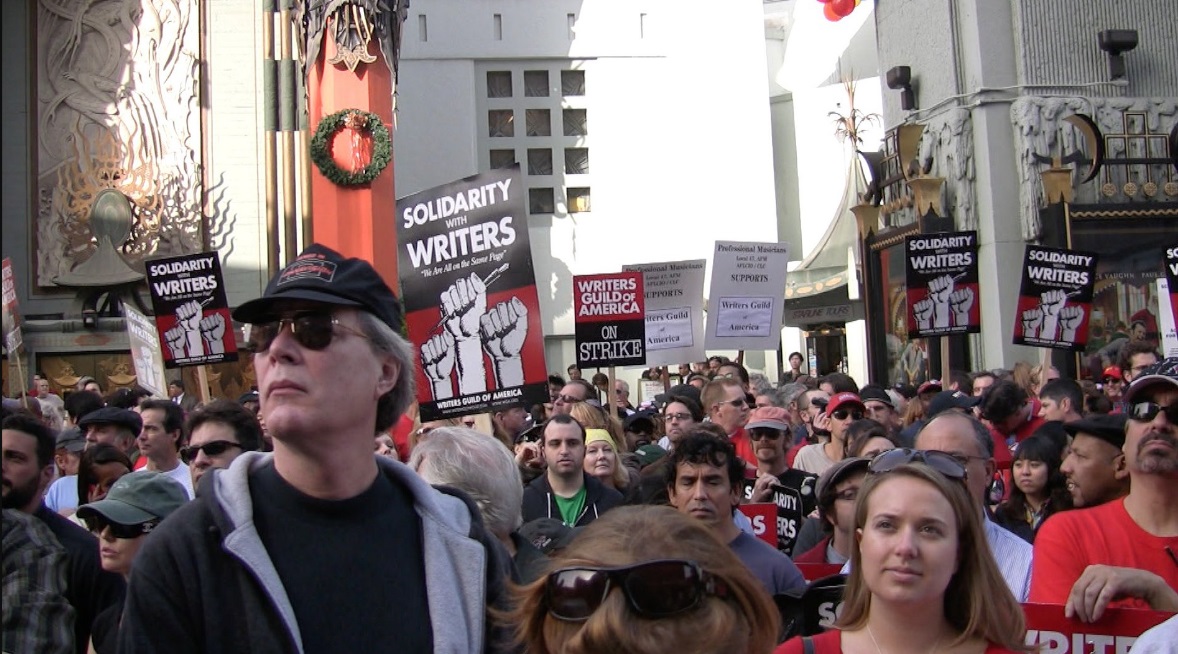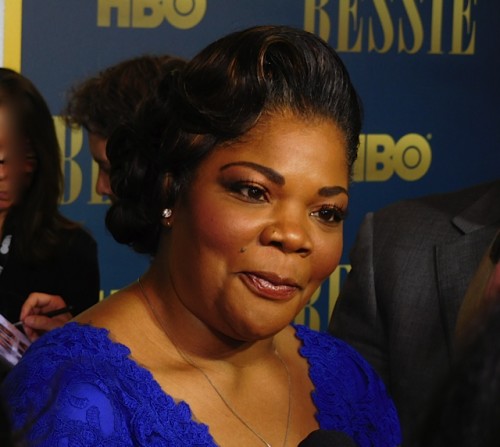Written by Katherine Murray.
Sometimes, I get fooled into believing that film sets are happy, magical places where artists immerse themselves in the joys of their craft and feel nothing but a deep sense of satisfaction at doing the work they love. Then, I watch a documentary like Pencils Down! The 100 Days of the Writers Guild Strike and remember that, for most people, this is a workplace like any other.
Pencils Down! chronicles the 2007-2008 Writers Guild of America (WGA) strike that largely brought television production to a standstill, through a combination of footage shot at the time, and reflective interviews shot in 2014-15. In his director’s note, Brian S. Kalata – a member of the WGA – explains that he originally envisioned this content as part of a larger project about labor unions in the U.S., and it’s clear that the seeds of that idea are still here. Pencils Down! is most invested in explaining why Americans need unions to protect their interests at the bargaining table (which they do), and somewhat less invested in what the WGA strike, specifically, accomplished (which is, arguably, not much).
The early parts of the documentary explain what the WGA strike was about – officially, residuals for work distributed over the internet; unofficially, residuals for work distributed on home video and DVD. Like every strike, though, the motivating factor is a sense of unfairness – of being exploited, cheated, and taken advantage of. It’s weird to see middle-class writers on strike, but whether you’re in a blue or white collar job doesn’t matter – even monkeys stop working if they find out they’re making less than everyone else. There’s something about being cheated that insults our basic sense of dignity.
When the Sony hack in 2014 last year revealed the gender wage discrepancies between the actors on American Hustle, Bradley Cooper went on record as saying that what Amy Adams was paid for her work was “almost embarrassing” and that he hoped she would speak up. It’s that sense of embarrassment that underlies many disputes over pay. What happened to Amy Adams (and to many other actresses, particularly women of color) is familiar to women in many workplaces – the sickening moment you realize that, the entire time you thought you were doing just fine, you were really sitting at the bottom of the pay bracket while all your male coworkers got more. Right now, it’s fashionable to blame women for that – negotiate more, try harder, do a power pose in front of the mirror, be more like a dude – but the problem isn’t people who are too humble. The problem between studios and screenwriters is people who are too greedy and snatch up all the profit they can, as if they had earned it alone.
In exploring the WGA strike, and the economics of how TV writers are compensated for their work, Pencils Down! circles back to the same core issues of fairness and greed. In a nutshell, many people felt that the writers union had been tricked into accepting a bad deal on home video residuals and, even though that wasn’t on the table during the 2007 strike, their sense of justice wouldn’t allow them to be forced into accepting a similar deal on online distribution. It’s not a question of whether they’re being paid middle-class wages – it’s a question of whether the studio’s offer was insulting within the larger context of the industry. Not working in that industry, I don’t have an opinion about whether or not that was the case. But Pencils Down! is a reminder that, for people who do work in the entertainment industry, it’s a business like any other business and a workplace like any other workplace – the struggles that play out in office buildings and factories also play out in production studios, and the fundamental tensions between employers and employees are the same.
One interesting facet of the writer’s strike explored in the documentary is that the WGA was striking against corporations that owned the mainstream media outlets. Several people argue that that skewed coverage of the strike made it more difficult for the union to explain what was happening to outsiders. I don’t know whether or not that’s true, but it does seem like a conflict of interest.
Another interesting aspect of the strike is that, as the documentary draws to a close, the success of the strike seems unclear. No one is emphatically sure that the stress and lost wages were worth it, and no one is overjoyed with the contract the union eventually signed. In some ways, the most important questions raised by Pencils Down! are whether it’s worth it to strike if you ultimately lose the negotiation – or whether American workers can strike in an effective way anymore, when the toll on them is so much higher than the toll on corporations. Those aren’t questions Pencils Down! ultimately engages with – instead, the triumphant mood of the film’s first three quarters is followed by an uncertain finale as Kalata’s interviewees take an “it could be worse” perspective.
In his director’s note, Kalata also explains that, while he began with a list of over 100 potential interview subjects, almost no one was willing to talk to him on record. Of those who do appear in the film, actor Alan Rosenberg explains that, while he was very outspoken in support of the strike, it may have hurt his career, and he now regrets some of his words.
Workers’ rights, including the right to receive a fair share of the profits from one’s work, are an issue that’s, paradoxically, both public and private. Many people would rather not know if they’re being paid less than their coworkers or less than they’re worth, because they’d either have to live with a feeling of shame or risk the long term discomfort and possible job loss that follows from confrontation. In some ways, the most important part of Pencils Down! is Kalata’s unseen list of hundreds of interview subjects who declined to appear – the story of why it’s so gauche to talk about payment and how many people fear reprisal for speaking out.
Pencils Down! The 100 Days of the Writers Guild Strike is currently available on iTunes and other streaming services.
Katherine Murray is a Toronto-based writer who yells about movies, TV and video games on her blog.






